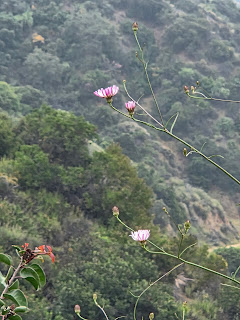Hiked June 8, 2025. Most recent hike (as of this writing), and the only the second "local" hike in a while.
A nearby friend posts frequently of he and his dog's walks or bikes (no dog!) up the trail. It's a fireroad, so plenty wide for non-technical biking, as well as hiking. Not sure if horses are also permitted. Dogs are permitted.
I may have made one hike on a different segment of the trail, a long, long time ago. Pretty sure this was the first time here. For me on this day, I parked near the end of Oakglade Drive in Monrovia. It's basically a continuation of North Canyon Blvd, if, instead of turning right, towards Monrovia Canyon Park, you continue "straight." Monrovia Canyon Park, btw, has been mostly closed due to fire and wind damage for the past five years, but is scheduled to reopen on June 27, 2025.
North Canyon Blvd, btw, does intersect with Foothill Blvd, about four blocks east of Myrtle (Old Town Monrovia), or seven blocks west of Mountain Ave. Most times I'm on Foothill, I manage to miss the sign for Monrovia Canyon Park, but, even without a sign for the park, there's a sign for the street, so a more careful driver (or one who has properly told their gps where to go) can find the street.
Where Oakglade turns into Ridgeside Drive, most of the area near the trailhead is either no parking, or resident parking (by permit), only. Once a week, it's also no parking for street sweeping. So, if you go check the signs to make sure you don't get ticketed.
On the day I hiked, it was pleasantly "June gloom," so overcast, even though it would warm up later in the day. That was helpful, since, at the time, I was on a course of antibiotics and was supposed to limit my sun exposure.
At the trailhead is a gate, with access permitted 6am - 9pm. Inside the gate, there's a big sign with a map, in case you want to take a picture and know where you can go from where you are. Also, there's a doggy poop bag dispenser, nearby.
Despite being June, there had only been a couple of hot days, so there were still quite a lot of flowers blooming, even at low altitude. I took pictures of most varieties I saw on this hike. Most, I can identify.
In order, it's lantana, California buckwheat, Spanish broom, California buckwheat, cliff aster, wild mustard, four times, then a big bull thistle, some sort of phacelia, a pair of morning glory, an unknown flower, a closs up of a cliff aster, then some fountain grass. At least, those are my guesses.
There is some signage along the way, which would indicate that the distance from the gate to the "Sunset Bench" is about 1 1/4 mile. Since you can't actually park at the gate, you'll likely walk 3 miles or more, roundtrip, from where you park to the bench and back.
There were other hikers and a biker I passed, but it actually wasn't very crowded for the time. I'm sure it can get busier, but, on the little segment I walked, it was pleasant enough. Nothing dramatic along the way, but nice.
I walked a pretty small segment of the entire road/trail, so there's several return trips, possible. On the other hand, it's mostly south-facing, and would get pretty hot under the sun. Not sure when I'll manage a return trip, with at least one starting at an alternate access point.
That's about all I have to say on this hike, although I did end up adding several "last thoughts," below.
Meanwhile, in terms of coming attractions, I managed a long/short trip to Chaco Culture National Historic Park. That's going to produce at least a few posts over the next to or three weeks.
I say long/short trip, because I was away from home for four days, which is relatively long, for me. And there were two nine-hour driving days, around two days of 4-5 hours of driving, all for two nights of camping, numerous short hikes, and one really long day of multiple hikes.
Yep, lots of photos to sort and try to put together into coherent stories. Who knows? Might even manage more hikes before I finish blogging that trip!
Oh, returning to this hike, I should note that I read about a LOT of bear sightings in the neighborhoods of Monrovia that abut the mountains, and the other hillside communities. Never hear about bad encounters, but there are a LOT of bears in the area, and many are habituated to people and their trash cans. So if you already have bear spray, it might be a good idea to keep it handy, and maybe try to avoid carrying aromatic foods on your hike.
Two other notes: Yes, dogs are permitted. I sort of implied that at the top. I would image there's a standard six-foot leash requirement. Regardless of that, you'll want to keep your dogs (especially smaller dogs) close by, since wildlife encounters are very possible, either with the bears I just mentioned, or coyotes or cougars, as is typical in the San Gabriel Mountains.
The gate is open from 6am to 9pm, btw. The good news is, apparently (I haven't tested this, myself), if you are a little late getting out off the trail, you can still open the gate from the inside, even if it's locked, from the outside.





























































